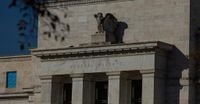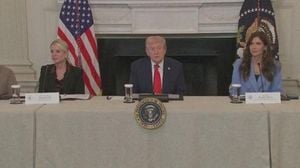The U.S. Federal Reserve found itself at the epicenter of political and economic drama on Tuesday, September 16, 2025, as it kicked off a pivotal two-day meeting widely expected to result in the first interest rate cut of the year. But the economic stakes were rivaled only by the political intrigue swirling around the central bank’s leadership, with President Donald Trump’s administration pushing for rapid changes at the top and a high-profile legal battle threatening to upend its governing ranks.
At the heart of the commotion was the swearing-in of Stephen Miran, a longtime Trump economic aide, as the newest governor of the Federal Reserve. According to AFP, Miran’s appointment came just hours before the Federal Open Market Committee (FOMC) convened to deliberate on monetary policy. The Senate had confirmed Miran by a razor-thin 48-47 vote late Monday night, a process that, as Dow Jones noted, marked the second-fastest Fed confirmation in more than 25 years. Miran steps into the seat vacated by Adriana Kugler, who unexpectedly resigned last month, and will serve out the remainder of her term, which ends in late January 2026.
President Trump himself announced Miran’s appointment to the Fed Board, emphasizing the importance of an independent central bank. As reported by Devdiscourse, Trump underscored the need for a “Free Federal Reserve,” even as he continued to publicly criticize Fed Chair Jerome Powell for what he sees as insufficient action to lower borrowing costs. “The Fed should listen to smart people like me,” Trump told reporters on Tuesday, doubling down on his calls for more aggressive rate reductions.
The timing of Miran’s arrival was no accident. The FOMC’s meeting—its first since December to consider a change in the benchmark lending rate—came amid mounting evidence of a weakening jobs market and growing market expectations for a 25-basis point rate cut. The Fed has held rates steady between 4.25 percent and 4.50 percent since December 2024, as it weighed the impact of Trump’s trade policies and tariffs on economic stability. According to AFP, investors are not just watching for this week’s rate move but are also keenly interested in signals about the pace and scale of further cuts in the coming months.
Miran’s role on the FOMC gives him a single but significant vote on interest rate decisions. Whether he will align with Trump’s push for steeper cuts remains an open question. Before joining the Fed, Miran served as chairman of the White House Council of Economic Advisers—a post he is taking a leave of absence from, not resigning, which has drawn criticism from Democratic lawmakers. His term at the Fed is short, just over four months, but his vote could prove crucial at a time when the central bank’s independence is under the microscope.
If Miran’s confirmation was a political victory for Trump, it was matched by a legal setback involving another Fed governor, Lisa Cook. On Monday evening, September 15, a panel of judges from the U.S. Court of Appeals for the District of Columbia Circuit blocked Trump’s attempt to remove Cook from the board over allegations of mortgage fraud, as reported by The New York Times. The court upheld a lower-court ruling that temporarily prevents Cook’s ouster while her legal challenge proceeds, ensuring she remains able to participate in the crucial FOMC meeting.
The allegations against Cook stem from claims that she falsified records and misrepresented multiple homes as her primary residence to secure better loan terms in 2021, before her appointment to the Fed. However, newly revealed documents cast doubt on these accusations, suggesting, according to records reviewed by The New York Times, that Cook was transparent about designating a condominium in Atlanta as a vacation property. Cook has not been charged with any crime, and the timing of the allegations—surfacing as the Fed faces a major policy decision—has raised eyebrows among observers wary of political interference in the central bank’s operations.
The Trump administration, undeterred by the appeals court ruling, signaled it would take the fight to the Supreme Court. As a White House official told Bloomberg, the Justice Department had not yet filed its petition but intended to do so soon. White House spokesman Kush Desai told AFP that the president “lawfully removed Lisa Cook for cause,” citing malfeasance or dereliction of duty, and added, “The administration will appeal this decision and looks forward to ultimate victory on the issue.”
The legal wrangling over Cook’s status is more than a personal battle; it has major implications for the Fed’s independence and its ability to set policy free from political pressure. If the White House had succeeded in removing Cook this week, she would have been barred from voting on the interest rate cut—a move that could have tipped the balance on the FOMC and set a precedent for future presidential interventions. The case is being watched closely by economists, lawmakers, and international observers, all of whom recognize the central bank’s credibility rests on its perceived autonomy from the White House.
Meanwhile, the Senate’s rapid confirmation of Miran—just two weeks after his nomination—has fueled concerns that Trump is seeking to reconfigure the Fed’s leadership with loyalists ahead of the 2026 presidential election. As The New York Times put it, the central bank faces an “awkward, potentially perilous moment,” with its political independence under new threat. Miran’s decision to take only a leave of absence from his White House post, rather than resign, has only heightened those anxieties, especially among Democrats who question whether he can truly act impartially while serving such a short term.
Trump’s ongoing feud with Chair Jerome Powell also looms large over the proceedings. Despite his rhetoric about the importance of Fed independence, Trump has repeatedly urged Powell to cut rates faster and deeper, blaming the central bank for what he sees as sluggish economic growth. The Fed, for its part, has argued that steady rates were necessary to guard against inflation risks posed by Trump’s own economic policies, including tariffs and trade tensions.
As the FOMC meeting unfolds, all eyes are on the central bank’s next move—and on the political machinations that threaten to shape its future. The outcome will not only affect the cost of borrowing for millions of Americans, but may also set the tone for the Fed’s role in the months leading up to a fiercely contested election season.
For now, the Federal Reserve remains on a knife’s edge, balancing economic headwinds, political crosswinds, and the ever-present challenge of maintaining public trust in its independence. With the legal fight over Lisa Cook far from settled and the ink barely dry on Stephen Miran’s appointment, the drama at the heart of America’s central bank is far from over.





